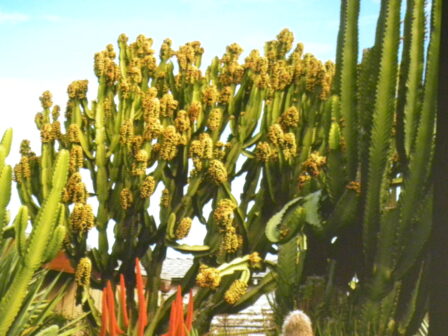On Behalf of Succulents
Jeff Moore, author and succulent nurseryman who spoke to the San Diego Horticultural Society in January, gave a fascinating lecture and slide show about succulents. They are plants which retain moisture for long periods of time (as a good thing). Cacti and succulents fall into this category. Tillandsias (air plants), bromeliads, and even some orchids are similar to succulents in their requirements. Aloes, derived from the lily family, have “learned how to hold their water,” says Jeff Moore. Some succulents can be eaten, others are used for medicinal purposes, and some even have hallucinogenic properties. Not all desert plants are succulents. Despite having fat, juicy bodies, some desert trees are still somewhat woody and are not succulents.
Succulents are becoming more and more popular for several reasons: They tolerate some neglect. They need very little water, which is nice when water usage is rationed. They do, however, need some water. In the wild they live shriveled, hoarding their moisture until there is a rainfall. Moore waters his succulents weekly or more often in extremely hot weather. Rain water is the preferred drink, but tap water can be amended with a teaspoon of distilled white vinegar in every five gallons of tap water. Experts may experiment with a drop of food or some chemicals; it is not necessary.
Succulents must be planted in a fast draining soil if they are to live in pots. Sand holds too much moisture, but a mixture of half gravel and perlite or pumice, half organic planter mix and five or ten percent of the mix and pumice combination can be sand. This should keep succulents happy. Moore says that perlite is not good to use in the ground; use pumice as perlite floats to the surface and “looks messy,” says Moore. Creating mounds of good “cactus” soil in the garden is a way of planting your succulents directly into the ground. The man-made mounds facilitate drainage and add interest to the landscape.
Succulents can be acclimated to strong sun, but if you have purchased yours from a store where it may have lived in shadier areas, gradually introduce it to longer and longer periods of bright sunlight. Christmas cactus can live and bloom for years without direct sun, but most succulents prefer at least bright or indirect light. String of pearls will burn with too much sun; mine (not thriving because they have been learning to conserve water; i.e. I forget to water them) do get a little early morning sun even though they are on a covered balcony. When they have water, they thrive.
Moore suggests any indoor succulents be rotated on a weekly basis: one week indoors, one week out. Direct sunlight produces the most vibrant colors. Show plants may be more protected, but in my opinion if you want to baby your plants, grow roses. Moore believes in exposing his plants to the elements, whatever they may be.
When you bring a succulent home, try to bring those which grow best in your microclimate. Ask where the plant thrives: extremes of temperature? Ocean breezes? Dessert sun? Snow?
Years ago Fausto Palafox told the Mission Hills Garden Club that using Miracle Gro was like putting your plants on steroids, not a good thing. Like Palafox, Moore advises against over-fertilizing. The plants may look great but eventually too much fertilizer will weaken them.
Moore confessed that at his own home, he sticks new plants wherever he sees a blank space. However, when he is designing a garden he follows what he calls “The three R’s of succulent garden design” or rocks, restraint, and repetition. He starts with rocks. Once they are arranged in a pleasing composition, he begins adding plants, grouping like-colors so they make a statement and stand out against other groupings. He repeats textures as well and sizes and shapes. He advises against covering every surface. Leave at least 20 percent bare, he recommends. This allows plants to grow and propagate and gives you places to add new plants.
The variety of colors, shapes, textures and sizes or succulents is so diversified that even those who loathe them should be able to find something to like. The slides Moore brought showed the varying shapes, colors, sizes, and configurations of succulents. Some look grotesque, like brains or organisms in a cadaver. Others look as if they are covered with lace. Some, lithops, for example, resemble rocks. Lithops do not fare well with too much or too little water. With too much water during their growing season, they explode. Too much during the dry season, they implode. They are cool looking if you can avoid killing them
Aloes are a common succulent with myriad varieties. Some are extremely rare. Flowers start with little spikes poking out of the plant. Eventually a spike or spikes of color or flower appears. Some aloe plants grow to 30 feet. Moore says many aloe leaves look as if they would hurt you, but in reality they are not sharp. However, agave, which resembles some aloes, can be treacherous. I carry clippers and snip the ends to walk past them. I often come out of my backyard bleeding profusely from my wounds.
As someone who disliked succulents, I have to admit, I’m becoming fond of them. With our drought, I really have no choice. In Moore’s book, “Under the Spell of Succulents,” he discusses various types of succulents, planting them, creating a garden, and even some information on bonsai. Having read the entire book and having been enticed by the photographs, I am now anxious to purchase more to augment those I have.
The March 28 meeting of the Mission Hills Garden Walk will take place from 6 to 8 p.m.at 4070 Jackdaw.
Category: Local News








